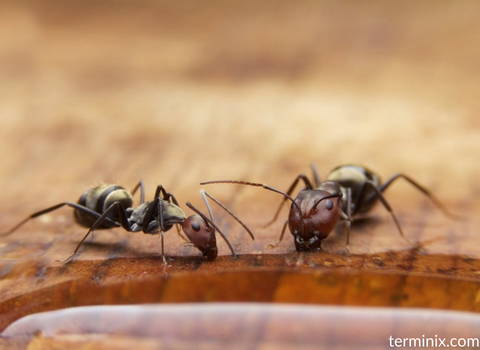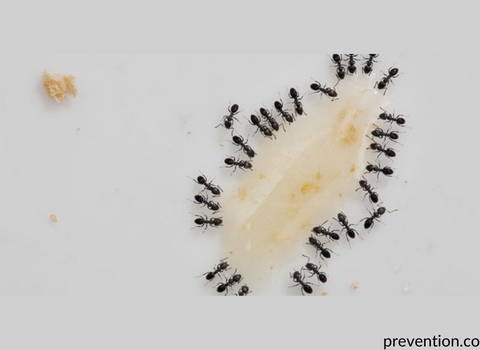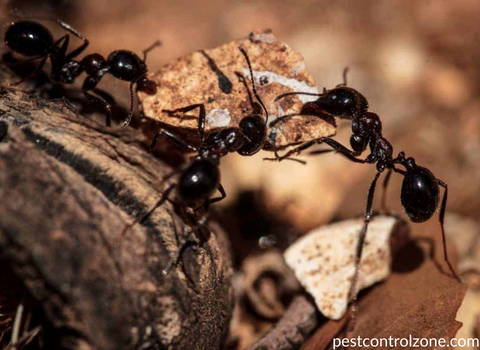Carpenter Ant Traps: Options Available and How to Use Them
Unlike termites, carpenter ants do not eat wood. Instead, they excavate wood to form tunnels where they will create nests. Mature western black carpenter ant colonies contain around 10,000 to 20,000 workers and one wingless queen.
Swarmers are only produced when the colony is over two years old. Carpenter ants tend to attack the wood with moisture problems and fungus, so you should always keep an eye on soft, decaying wood and excess moisture around your home.
They may also build nests in dead trees, buried wood, decaying wood, tree stumps and damp wood.
What are Available Carpenter Ant Killers?
Carpenter ants can damage your home’s structure as they tear holes through the wood to build their nests. The worst part is that once you have carpenter ants in your home, it is nearly impossible to eliminate them.
That is why it is important to find the right solution that can control carpenter ants and get rid of the entire ant colony permanently.
Carpenter ant killers are a cost-effective and easy alternative to a professional exterminator. The best thing about a carpenter ant killer is that it comes in different forms – granules for outdoor applications to prevent carpenter ants from entering your home sprays to kill ants on contact and liquid baits like the following:
Terro Liquid Ant Baits are well known to attract, infect and kill worker ants. These products help in spreading the bait in their colony and bringing it to their queen.
The products mentioned above are all proven to be effective when it comes to dealing with an ant infestation. However, you should also learn the types or forms of ant killers that you need to use for your ant problem.
There are two kinds of formulas for killing carpenter ants – kill-on-contact pesticides and baits. Kill-on-contact pesticides are usually sold in aerosol spray bottles. It is a liquid insecticide that kills carpenter ants within seconds upon contact.
On the other hand, ant baits come in different forms. Each kind of ant bait kills carpenter ants differently and has a different method of application. Here is what you need to know about the best carpenter ant killers that can attract carpenter ants.
Dust Ant Killers
These products use diatomaceous earth (DE), a substance that is poisonous to carpenter ants. When they crawl through the substance, it enters their exoskeleton and dehydrates them.
Bait Stations
These plastic receptacles have tiny holes that allow carpenters to enter and collect a bait gel or liquid bait and then leave. The liquid or gel bait does not kill them right away, so the ants will have time to go back to their colonies and infect other carpenter ants with the ant bait.
Granules
Granules dissolve when sprinkled on the ground. It leaves a residue, which kills ants upon contact. Aside from killing carpenter ants, granules also treat the soil, and this creates a barrier that can prevent ants from entering your home.
Ant Spray
These products have gluey liquid ant baits that you can apply directly to ants to kill them upon contact. You can also apply the product to crevices and cracks where ants usually hide or enter.
This type of product kills carpenter ants within a few seconds of contact. Thus, it is a good option for those who are looking for liquid ant baits that provide quick results.
How Do Traps for Carpenter Ants Work?
Ant traps contain food baits that attract ants plus an ant poison or insecticide. The food usually consists of fats, proteins and carbohydrates for carpenter ant removal and kills insects after several days. Ants recruit other workers to gather the bait and bring it back to their nest.
The bait is mouth-to-mouth transferred to the queen and larvae to kill ant colonies. Ant bait should be slow-acting so that worker carpenter ants have time to return to their nest and feed the rest of them before they are killed.
Ant traps are one of the most effective and easiest long-term solutions to ant infestations and ant removal. But since carpenter ants are extremely picky when it comes to meeting the colony’s nutritional needs, tempting them to accept liquid ant bait requires persistence, skill, and knowledge. So here are some tips for baiting and killing ants.
Placement
Place the bait in suspected or known ant activity areas like behind furniture, in the attic or basement, under kitchen cabinets and other possible entry points from the outside. Avoid placing the bait in areas with moisture and sunlight because these factors can reduce the freshness of the bait. For best results, place the bait in dark, dry, and cool areas.
Testing
Place small amounts of bait where you see foraging carpenter ants then observe them. If they are not interested in the bait, you should replace it with a different option.
Quantity
Check the ant bait frequently to make sure that it is not depleted. You should also place bait in different locations. When carpenter ants stop feeding, wait at least three or four days before replacing or removing the bait.
Safety
Keep the bait out of reach of pets and children. Do not place the bait on countertops or tables where you prepare food. You should also keep it away from the sink, drain, crawl space, pet’s water and food bowl or areas where it may contaminate drinking water.
Sanitation
Remove any food items from the baited areas. Otherwise, they will be distracted and avoid the bait. Do not forget to check the infested areas for any feeding signs. If the bait is no longer interesting to carpenter ants, replace it with a new one.
Patience
Since most ant baits are designed to be slow-acting, you may not get results immediately. So be patient and just check the baited spots to see if there are feeding activities there.
Are Ant Traps Enough in Controlling a Carpenter Ant Infestation?
Carpenter ant baits do not work on all ant species, particularly those that attack different kinds of wood. Moreover, carpenter ants prefer sugar-based baits, while some ants such as little black ants are more interested in fat-based baits.
You can call a pest control professional to help you identify the kind of carpenter ant species you are dealing with. They can also create a comprehensive carpenter ant control plan and determine the best carpenter ant bait for your situation.
How to Find Carpenter Ant Nests
Identifying carpenter ant infestations and ant nests early is essential to prevent damage to your home’s structure and get rid of carpenter ants permanently.
Common signs of carpenter ant infestations include ant sightings, wood shavings or frass, hollow wood or wall voids, small holes in wood and the presence of ant wings. Foraging ants leave the nest to find food, so spotting them is a clear sign of a carpenter ant problem.
After mating, swarmers lose their wings. So, finding discarded ant wings near windows and doors is another sign of infestation. As carpenter ants excavate wood, they remove dead ants and other insects and wood blocking their way. The wood shavings can be found on the floor, underneath wooden objects and near walls.
The longer they go unnoticed and treated, the more damage they cause. So, tap your walls to check for any signs of carpenter ants. If the walls sound hollow, it is a sign of a black carpenter ant problem. Finding small holes in wood is also another sign of carpenter ant infestation. Ants use these holes to get rid of wood debris and dead insects from their nests.
Locating ant nests can help you kill carpenter ants and get rid of an ongoing carpenter ant infestation. Here are some tips on how to find carpenter ant nests.
Watch out for signs of an infestation
Unexplained piles of wood shavings and holes in wood, hollow doors and foraging workers are common signs of carpenter ants.
Check areas where moisture accumulates
Inspect the wood near windowsills, appliances, sinks, doors, and showers.
Listen
Perhaps you heard rustling noises from the walls. Tap the walls to see if there are hollow areas in there. Wall voids are a sign of carpenter ant infestation.
Follow carpenter ant trails
If you saw an ant trail, follow it because it might lead you to their nest. Carpenter ants are usually come out at night, so this is your chance to find them.
Once you find them, use the best carpenter ant killer to get rid of your carpenter ant problems for good. You can also use boric acid to get rid of carpenter ants and other insects because it is toxic to them.
Boric acid comes in liquid bait form or dry powder with a food attractant. But if the problem is too severe, it is time to call an expert in carpenter ant control and other pests to get rid of the entire colony.
They will assess the problem and create the right carpenter ant control plan for your situation to get rid of the indoor nests and satellite nests. So, look for a professional that specializes in different ant species like Florida carpenter ant, Argentine ants, carpenter bees and other ants to get rid of carpenter ants for good.




